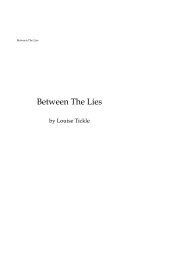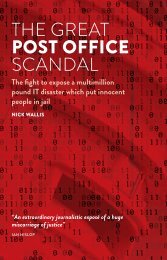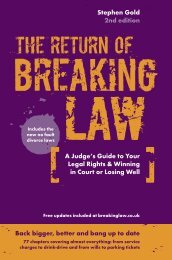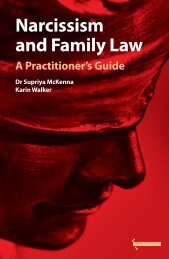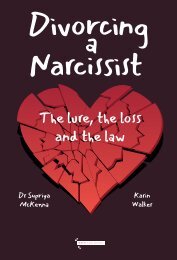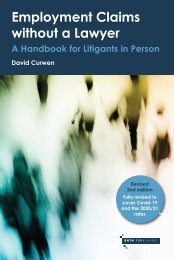Insolvency Made Clear: A Guide for Debtors
Plain English, practical guidance for anyone facing demands over a debt they are struggling to pay.
Plain English, practical guidance for anyone facing demands over a debt they are struggling to pay.
Create successful ePaper yourself
Turn your PDF publications into a flip-book with our unique Google optimized e-Paper software.
Effect Of Bankruptcy<br />
Finally, the following claims are theoretically possible but they are almost<br />
never used:<br />
5. Assignment of book debts: s344 of the Act. When someone trades, they<br />
are likely to have a list of debtors who owe them money. It is possible to<br />
assign the debtors to a third party so that the third party can collect the<br />
money. Such an assignment would not bind the Trustee unless the assignment<br />
has been registered under the Bill of Sales Act 1878. Such registration<br />
requires an application to the Queen’s Bench Division of the High Court. It<br />
is not common to have such a general assignment of debts.<br />
6. Excessive pension contributions: s342A of the Act. Where an individual<br />
has made ‘excessive’ contributions to their pension which has unfairly prejudiced<br />
the creditors, these can be claimed back by the Trustee. This rarely<br />
applies due to the difficulty in showing that the payments were indeed excessive.<br />
It is often easier to show that the pension payments were made to<br />
remove the assets from the estate, i.e. to bring a s423 claim.<br />
7. Extortionate credit transactions: s343 of the Act. If the bankrupt takes<br />
out a loan with ‘grossly exorbitant’ repayments or otherwise ‘grossly contravenes<br />
ordinary principles of fair dealing’ then this can be undone. An<br />
exaggerated example would be where the bankrupt took out a loan of £100<br />
<strong>for</strong> a month, and then had to repay £10,000 30 days later. This is rarely<br />
applied due to the difficulty in showing that the loan was extortionate. If<br />
the loan is so extreme, the Trustee may be suspicious it was a transaction<br />
at an undervalue.<br />
2.7 Calculating the debts of the bankrupt<br />
The Trustee will compile a list of the debts of the bankrupt. Potential creditors<br />
will be asked to ‘prove’ their debt, i.e. demonstrate that the bankrupt owed them<br />
a certain sum of money. Creditors owed debts of less than £1,000 will not need<br />
to submit <strong>for</strong>mal proof but will be believed automatically unless there is some<br />
reason to challenge the debt: r14.1(3) and para 18A of Sch 9 of the Act.<br />
The making of a bankruptcy order stops the clock on interest accruing under a<br />
debt. Creditors will prove <strong>for</strong> the amount owed as of the date of the bankruptcy<br />
order. After then, all interest on debts will accrue at the statutory rate of 8% p.a.<br />
25



